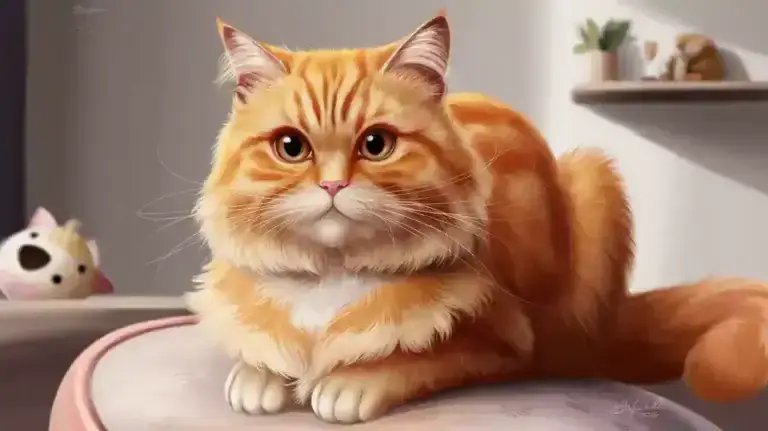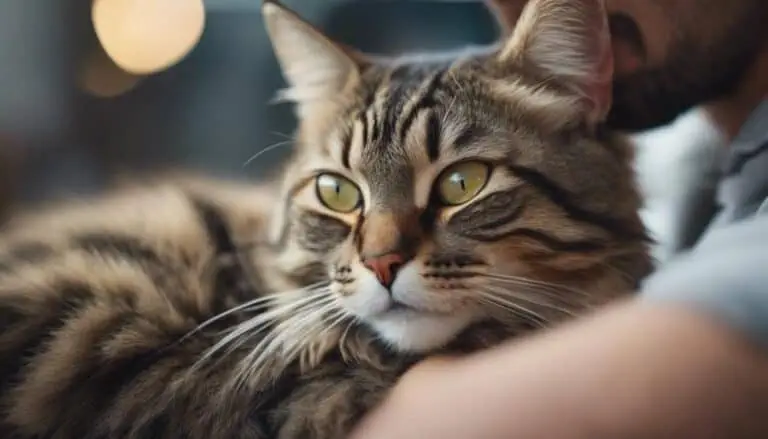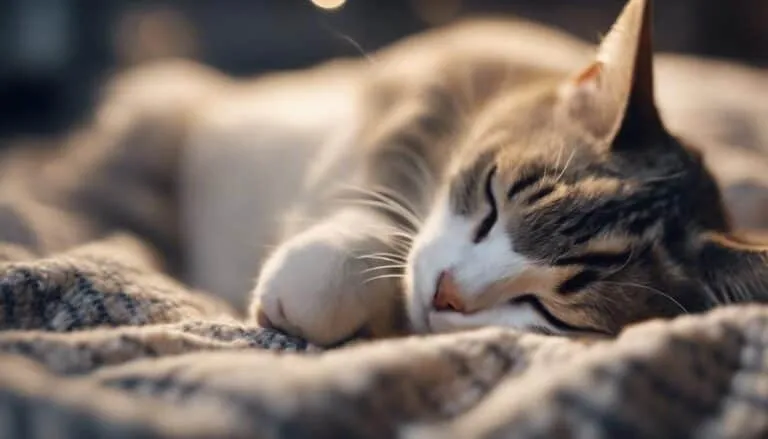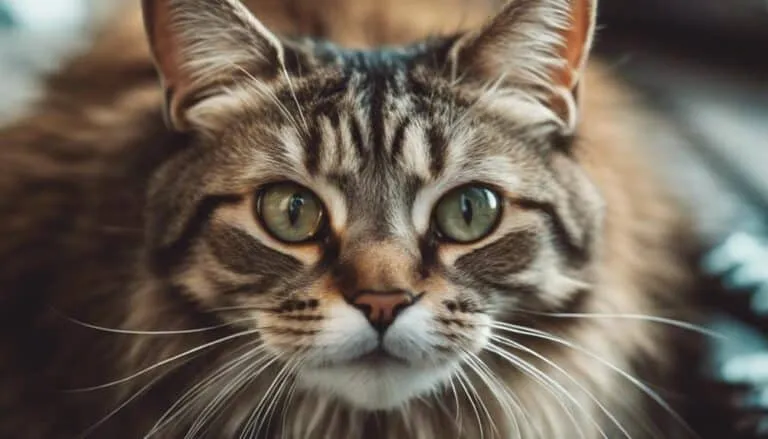The Best Fluffy Pancakes recipe you will fall in love with. Full of tips and tricks to help you make the best pancakes.

The coexistence of cats and goldfish has long fascinated pet owners, sparking both curiosity and concern. While the notion of these two creatures sharing a living space may initially seem harmless or even amusing, there are underlying complexities that deserve attention.
What happens when a natural predator, like a cat, encounters a delicate prey such as a goldfish? Are the risks truly as grave as they seem? In this article, we will explore the intricacies of this relationship, shedding light on the potential dangers and offering valuable insights into how to navigate this precarious combination.
Prepare to be surprised as we unravel the truth behind the cats and goldfish dynamic.
Key Takeaways
- Most cats are not natural fishers and would rather avoid water.
- Cats are generally not interested in eating live goldfish and prefer easier alternatives like their regular cat food.
- Feeding live goldfish to cats is not recommended due to various risks such as choking hazards, parasites, and bacterial infections.
- It is important to prevent cats from accessing goldfish by using a secure fish tank and placing it in a high location away from the cat's reach.
Cats' Natural Behavior Towards Goldfish
Cats' natural behavior towards live goldfish is primarily characterized by fascination rather than predatory instincts. While cats are known for their hunting abilities, they are not natural fishers and would typically avoid water. In fact, most cats don't actually eat fish as part of their natural diet and prefer their regular cat food.
When it comes to goldfish, cats are more likely to stare at them in fascination rather than try to eat them. While there are stories of cat owners losing goldfish to their cats, it is not the norm. Cats' preference for other food options, such as their regular cat food, is stronger. However, hungry cats may be more inclined to eat goldfish, especially feral cats or those with specific breeds and temperaments.
In general, feeding live goldfish to cats is not recommended due to various risks such as small fish bones causing choking hazards or injuries to the cat's mouth, throat, or digestive system. Goldfish can also carry tapeworms, which can be passed on to cats. Furthermore, goldfish may be contaminated with heavy metals or poisons, and raw fish can carry bacteria that can make a cat sick.
Therefore, it is considered cruel to feed live goldfish to cats, and a safer and more nutritionally complete alternative is canned fish cat food. To prevent cats from accessing goldfish, it is important to use a heavy and strong fish tank, properly cover the tank, place it in a high location away from climbable objects, and avoid putting lights or other moving objects in the tank that may attract the cat.
Additionally, keeping the cat well-fed and providing sufficient toys and entertainment can help deter their interest in goldfish.
Cats' Preference for Other Food
Cats exhibit a strong inclination towards consuming their regular cat food rather than live goldfish. Their preference for other food options can be attributed to various factors. Here are three key reasons why cats prefer their regular cat food over goldfish:
- Natural Diet: Cats are obligate carnivores, which means their bodies are adapted to consume animal-based protein. While fish may seem like a suitable option, it is not a key part of their natural diet. Cats rely on their regular cat food to meet their nutritional requirements.
- Signs of Cat Hunger: When cats are hungry, they prioritize finding a familiar and easily accessible food source. Their instinctual behavior leads them to seek out their regular cat food rather than expend energy hunting live goldfish.
- Feral Cats and Fish: Feral or undomesticated cats may be more inclined to go after fish if given the opportunity. Their survival instincts drive them to hunt for any available food source, including fish. However, even feral cats have a preference for easier alternatives like small mammals or birds.
Understanding cats' natural behavior and preferences is crucial in providing them with appropriate nutrition and ensuring their well-being. By offering a balanced and complete diet through their regular cat food, cat owners can meet their pets' nutritional needs while minimizing the risks associated with consuming live goldfish.
Risks Associated With Cats Eating Goldfish
The consumption of live goldfish by cats can pose various risks to their health and well-being. While cats are not natural fishers and may not be inclined to eat goldfish, there are still potential health concerns with feeding goldfish to cats.
Small fish bones can present a choking hazard or cause injuries to a cat's mouth, throat, or digestive system. Additionally, goldfish can carry tapeworms, which can be passed on to cats.
There is also a risk of goldfish being contaminated with heavy metals or poisons, which can be harmful to cats if ingested. Furthermore, raw fish can harbor bacteria that may make a cat sick.
Given these risks, it is recommended to avoid feeding live goldfish to cats and instead opt for safer and nutritionally complete alternatives such as canned fish cat food.
Recommendations Against Feeding Live Goldfish to Cats
Feeding live goldfish to cats is strongly discouraged due to the potential risks and hazards involved. Here are three important reasons why it is not recommended:
- Ethical concerns regarding feeding live animals to pets: It is important to consider the ethical implications of feeding live animals to our pets. Goldfish are living creatures with their own needs and should not be used as entertainment or prey for cats.
- The importance of providing a balanced and nutritious diet for cats: Cats require a diet that is specifically formulated to meet their nutritional needs. Feeding them live goldfish does not provide the necessary nutrients and can lead to imbalances or deficiencies in their diet.
- Safety concerns for cats: Feeding live goldfish to cats can pose various risks. Goldfish bones can be a choking hazard or cause injuries to a cat's mouth, throat, or digestive system. Additionally, goldfish may carry parasites, bacteria, heavy metals, or poisons that can harm the cat's health.
Instead of feeding live goldfish, it is recommended to provide cats with a balanced and nutritious diet, such as high-quality commercial cat food. This ensures that their nutritional needs are met while also considering their safety and ethical treatment.
Preventing Cats From Accessing Goldfish
To ensure the safety of both cats and goldfish, it is crucial to implement effective measures that prevent cats from accessing the aquarium or fish tank.
Creating a cat-friendly environment plays a vital role in preventing goldfish access. Providing cats with ample food, toys, and entertainment can reduce their curiosity towards the fish. Additionally, training cats to ignore goldfish in the household can be achieved through positive reinforcement and redirecting their attention to other activities.
Placing the aquarium in a high location, away from climbable objects, can further prevent cats from reaching the tank. It is also important to avoid putting lights or other moving objects in the tank that may attract the cat's attention.
Cats and Goldfish: Common Myths Debunked
Contrary to common misconceptions, the relationship between cats and goldfish is often misunderstood, with several prevalent myths that need to be debunked.
To provide a clearer understanding of this topic, it is important to address the following common myths:
- Cats' fascination with moving objects: While it is true that cats are generally attracted to moving objects, their fascination with goldfish is often exaggerated. Most cats are not natural fishers and would rather avoid water altogether. They may be curious about the goldfish in a tank, but it is unlikely that they would actively try to catch or eat them.
- The importance of providing mental stimulation for cats: Cats require mental stimulation to prevent boredom and destructive behavior. However, the notion that goldfish serve as a suitable source of mental stimulation for cats is a myth. Cats need interactive playtime, puzzle toys, and other engaging activities to keep them mentally stimulated. Goldfish alone cannot fulfill this need.
- The risk of cats eating goldfish: While some cats may eat goldfish, it is not as common as one might think. Most cats prefer their regular cat food and view goldfish as an occasional curiosity rather than a meal. Feeding live goldfish to cats is not recommended due to the potential risks, such as choking hazards, injuries, parasites, bacterial infections, and contamination. It is best to stick to safe and nutritionally complete cat food options.
Signs That Your Cat May Be Interested in Goldfish
Cats may exhibit various behaviors that indicate their interest in goldfish. Understanding feline curiosity and exploring cats' hunting instincts can help identify these signs.
One common behavior is intense staring at the fish tank, with eyes wide open and ears perked up. This indicates a cat's fascination with the movement and colors of the goldfish.
Another sign is pawing or batting at the tank glass, trying to interact with the fish. Some cats may even try to jump or pounce on the tank, mimicking their hunting instincts.
It is important to note that not all cats show interest in goldfish, as individual preferences vary. Monitoring these behaviors can help cat owners take necessary precautions to prevent any harm to both the cat and the goldfish.
How to Safely Introduce Cats and Goldfish in the Same Household
Understanding the dynamics between cats and goldfish is crucial in ensuring a safe and harmonious coexistence within the same household. Properly introducing cats and goldfish in a controlled environment is essential to minimize any potential risks. Here are three important steps to create a safe and stimulating environment for both cats and goldfish:
- Gradual Introduction: Begin by placing the fish tank in a secure location where the cat cannot access it. Allow the cat to observe the fish from a distance, gradually reducing the separation over time. This controlled exposure helps the cat become familiar with the fish without feeling threatened or overly excited.
- Environmental Enrichment: Provide the cat with plenty of mental and physical stimulation to divert their attention from the fish. Interactive toys, scratching posts, and high perches can help keep the cat engaged and entertained. Additionally, consider adding hiding spots and plants around the fish tank, creating a more natural environment for the cat.
- Supervised Interaction: Once the cat has become accustomed to the presence of the fish, allow supervised interactions. Keep the cat on a leash or in a separate room with a transparent barrier, ensuring the safety of both the cat and the fish. Gradually increase the duration and proximity of these interactions, always monitoring their behavior closely.
Alternatives to Live Goldfish for Cat Entertainment
There are various alternative options available to provide entertainment for cats without the need for live goldfish. Interactive toys are an excellent choice for engaging cats and keeping them mentally stimulated. These toys can mimic the movement of prey, such as mice or birds, and encourage cats to engage in natural hunting behaviors.
Additionally, DIY cat enrichment activities can be a cost-effective and creative way to keep cats entertained. Simple activities like hiding treats in puzzle toys or creating homemade scratching posts can provide hours of entertainment for cats.
It is important to choose toys and activities that are safe for cats, avoiding small parts that could be swallowed or potentially harmful materials.
Frequently Asked Questions
Can Cats Be Trained to Live Peacefully With Goldfish?
Training techniques can be used to teach cats to peacefully coexist with goldfish, although potential risks still exist. It is important to provide proper training, supervision, and environmental enrichment to ensure the safety of both the cat and the goldfish.
Are There Any Health Benefits for Cats to Eat Live Goldfish?
There are no health benefits for cats to eat live goldfish. In fact, it can have harmful effects such as choking hazards, injuries, and potential transmission of parasites or bacteria. Feeding canned fish cat food is a safer alternative.
How Can I Tell if My Cat Is Interested in My Goldfish?
To determine if your cat is interested in your goldfish, observe their behavior. Signs of interest may include staring, pawing at the tank, or trying to access the fish. Ensure fish tank safety by using a heavy tank, covering it properly, and placing it in a high location.
Can Cats Be Trusted Around a Fish Tank if They Have Never Shown Interest in Fish Before?
When considering whether cats can be trusted around a fish tank, it is important to observe their behavior and introduce them to the tank gradually using training techniques.
What Are Some Safe Alternatives to Live Goldfish for Cat Entertainment?
Safe alternatives to live goldfish for cat entertainment include cat toys, such as fish-shaped catnip toys. These toys provide a safe and interactive way for cats to play and satisfy their natural instincts, without the risks associated with live fish.
Conclusion
In conclusion, it is crucial for pet owners to understand the natural behavior of cats towards goldfish and the potential risks associated with cats consuming live fish.
Feeding live goldfish to cats is not recommended due to the potential harm it can cause to both pets.
Instead, alternative feeding options should be explored to ensure the well-being of both cats and goldfish.
By implementing preventative measures and providing appropriate care, a safe and harmonious environment can be maintained for both pets.








